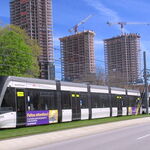dowlingm
Senior Member
Still think the reaction of Brampton to this link will make the HMLRT debacle seem like a gentle breeze.
You may recall the pre-election promise of doubling GO train service to KW by end of the year.....it was always carefully worded and had some people excited that it meant a doubling of the service in the hole corridor.....of course what GO/ML really meant that instead of two of the current (or recently expanded) trains in each direction serving KW, 4 would do so. It always meant "2X trains to KW" not "2X as many trains in the KW corridor".
Anyway, as things do, the key part of that (a new, expanded layover area) was slow in starting...it has now started and the doubling of trains to KW now looks to be a late 2016 thing.
http://www.cbc.ca/news/canada/kitch...-service-thwarted-by-30-km-of-track-1.3320962
EDIT....now that I think of it....even the date may have been a careful wording thing...I can't recall if they said before 2016 or before end of 2015 or "by" 2016....if it was the latter, I may have falling into the trap of forgetting that any date in 2016 is as much meeting that promise as the first of January.
The CTC system has finally been activated on the Guelph sub/Kitchener line, today was the first day of service. Word is CTC on the remainder of the Newmarket sub/Barrie line from Machell(Aurora) to Painswick(Barrie South) will also finally be in service before the end of the year. This will result in the complete elimination of non-signaled (OCS) territory on all GO lines. The CTC installation was a prerequisite to more service.
I know much of the issue is the quality of tracks, but would having proper signalling in place make any difference in the speed trains can travel on the Guelph Sub?
Americans also wonder about VIA trains doing 100mph without cab signals/PTCIn theory yes, but it is not sufficient. Lack of signalling sets an upper limit on what speeds can be. In the US, by law, 'dark territory' is limited to 59 mph. Canada is a little less rigid here, but the regulator has become quite uncomfortable about speeds (and train frequency) in unsignalled territory.
The 2015 will presumably become 2018 when the recently passed extension becomes law.(1) Prior to December 31, 2015, where any train is permitted to operate at a speed of 80 or more miles per hour, an automatic cab signal, automatic train stop, or automatic train control system complying with the provisions of this part shall be installed, unless an FRA approved PTC system meeting the requirements of this part for the subject speed and other operating conditions, is installed.
(2) On and after December 31, 2015, where any train is permitted to operate at a speed of 80 or more miles per hour, a PTC system complying with the provisions of subpart I shall be installed and operational, unless FRA approval to continue to operate with an automatic cab signal, automatic train stop, or automatic train control system complying with the provisions of this part has been justified to, and approved by, the Associate Administrator.

Are any of the PSOs or TSOs between Kitchener and Georgetown? How do the engineers know when to slow down for a PSO or TSO? Do they have to watch for the mile post signs along the track or is the number displayed inside the cab on a screen?
How do the engineers know when to slow down for a PSO or TSO? Do they have to watch for the mile post signs along the track
or is the number displayed inside the cab on a screen?
Maybe one day the railway(s) will finally modernize and stop using archaic methods. Every thing is still basically done on paper. We have to pick up our DOB's on paper at the crew center, we have to carry a thousand plus pages of documents in our grips(backpacks). We have to remember to call a foreman working out on the track who's in charge of the safety(the lives) of up to dozens of people with nothing more to remind us than a notation on a peace of paper and temporary signals flags that can easily fall over on the side of the track. Peoples lives are at stake using such flimsy method. Honestly it's embarrassing how far behind the railways in Canada are in communications technology. Instead of having a computer in place that could easily give us real time updates of our location and upcoming restrictions we have to rely on a hundred year old paper based system, just smh.
I would've thought that an app could be developed to provide a digital sense of the mile location. I wouldn't think with GPS technology it would be that hard or costly to create but I could be wrong as this is outside my area of expertise.
think I've also seen mile markers on signal poles. Am I correct?




